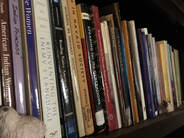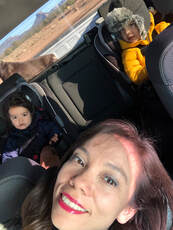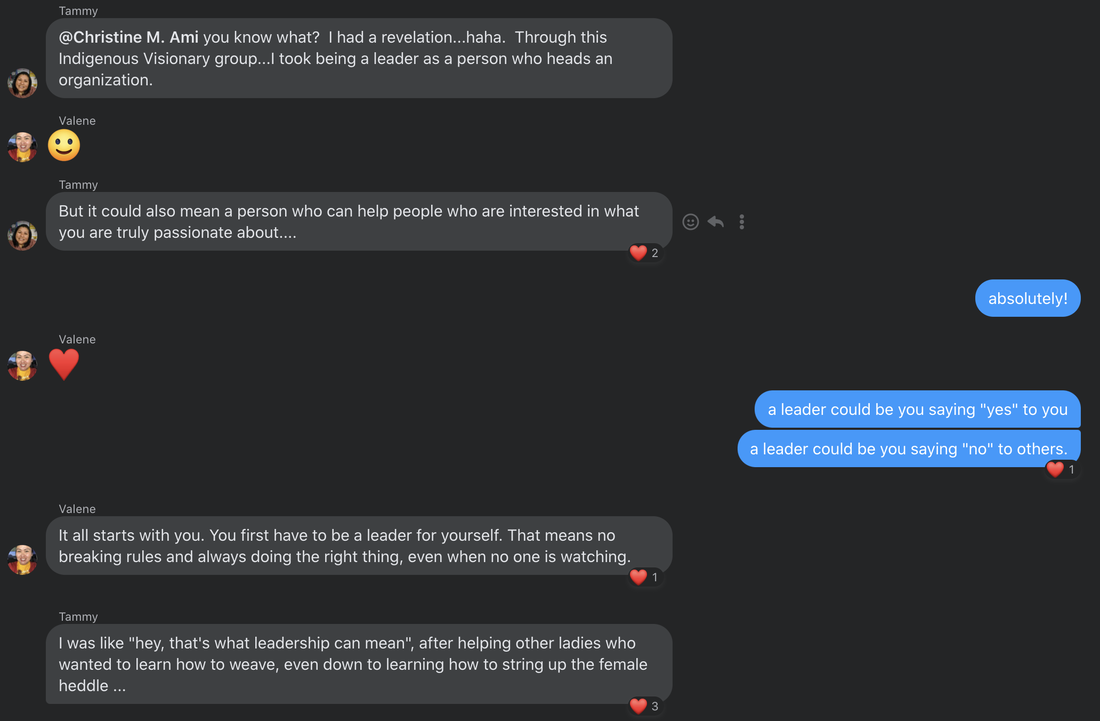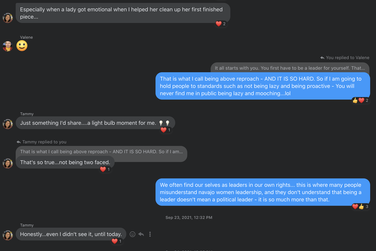Dr. Christine Ami2020/21 American Indian College Fund Indigenous Visionaries Mentor
But I envisioned what the fellows could accomplish with such an opportunity so I put together a grant proposal based around three specific areas: (1) cultural knowledge of Navajo leadership and weaving; (2) economic knowledge of traditional Navajo female leadership and weaving sales; and (3) technical knowledge (practical experience) of implementing leadership skills and weaving techniques. Apart from those 3 goals, I wanted the fellows to gain insight into the practical maneuvering associated with my role as a grant manager, program manager, and instructor. This kind of knowledge could provide them with an example of how Native leaders (male and female) holistically approach their work and personal life. We often forget that how we care for our home and our immediate family is an excellent indicator and reflection of who we are as people. Too often, we, as a Native community, celebrate the work successes of our Navajo leaders but not much light is dedicated to how they ground themselves with family (or if they don’t). So this fellowship allowed for the fellows to observe how I balance (or don't balance) my responsibilities and obligations as a Navajo woman and as a college community member. And here is what we, Tamerra Martin, Valene Hatathli, Sue V. Begay, and I learned. The first lesson I learned from my fellows is that it is primordial to continually ground ourselves in our own powers as Navajo individuals, it's more important that establishing a public identity as a community leader. Tammy's interview with weaver Gloria Begay reinforced this teaching for me. Gloria's mother taught her that "You have ten fingers, those ten fingers are given to you so that you can take care of yourself; work with your hands”. That's right!, I thought reading that: Bilá’ ‘ashdla’ii nishłį́, Nihookaah Dine’é nishłį́, Diné nishłį́ - that is who I am - a 5 fingered, powerful, and blessed Navajo person - that is my affirmation to maintain self-motivation. And with both of my hands, the best work that I can do is lead myself with self-determination because it is what I have been built with. The next lesson that I learned was that our cultural arts has helped to inform the development of leadership abilities across generations. Valene interviewed Dr. Delores Greyeyes, the Director of Navajo Department of Corrections. Dr. Greyeyes was raised in a single parent household. Her mother was a weaver and used that skills to provide for her family. As Valene found out: "It is one's choice to act or to be idle. Everyone has a leadership journey; it begins with knowing yourself, the environment you are in, and finding solutions". That is how Dr. Greyeyes learned about T’áá hwo ajitéego , the practice of personal accountability. Another lesson in Navajo female leadership that the fellows brought forth was the need to make sure that we don't live for us, but for the future. Tammy worked with weaver, Marilyn Vigie Fausto, to expand her techniques in the twill weave. Tammy and Vigie had known each other for years before deciding to work as in a mentor/mentee relationship. I loved this set up because there is so much that we can learn from our peers - it's not just age that brings knowledge. But one of the strongest messages that was brought forth in this pairing was the ability to take what you have learned and teach someone else. Tammy recapped the terms of their agreement: "Marilyn agreed to teach me as long as I promised to teach others, even if it meant I teach my daughter". Planning for the future. There is a sense of humility - ádaahwiinítį́. Yes, I want to learn but it's not all about me anymore - It's not about me at all - It's for future generations. My fellows also taught me about self-assessing - siih hasin. And not the fluffy "let's self-reflect about all the good" - a kind of self-reflect about what needs to change. That self-reflection brings us back to re-evaluating our personal values and our immediate and long term goals. And here is where my fellows really taught me - As a leader: it's okay to not be able to do it all, it's okay to not be everywhere, it's okay to place family over work and weavings over publishings, and it's even okay to cut off negative relationships, to start new goals, and to admit when you are wrong. Sue V. Begay taught me that when she realized that she needed to work on family and weaving a bit more before she could commit full time to this fellowship. Direct, honest, and self-reflective communication based on self-assessment.  One of my shelves ... One of my shelves ... Mentee Growth: By the end of this fellowship, the fellows learned new weaving techniques with mentorships, practiced their conversation skills through interviews, learned about cultural arts businesses through business planning classes and workshop leading - all through the lenses of Navajo women leadership. Mentor Growth: I created new class syllabi for the emerging Native American Studies Minor program here at Diné College. One of which is NAS208: Native American Women. It's filled with topics from Indian Princesses to Women Warriors to Political Leaders to Matrilineal Obligations and Responsibilities. I was able to work on other topics that interested my fellows and created ; NAS301: Traditional Ecological Knowledge and NAS401: Indigenous Human/NonHuman Animal Relations classes. These classes address our relationships to the world around us, placing the environment and non-human animals as the protagonist in a world where we are not the center of attention but rather a link in an intricate web. I also completed an article manuscript based upon the memoir writing retreat entitled: "A Native Scholar Pushing Back: Epistemological Imperialism, Cultural Gaslighting, and Credential Theft." (forthcoming). That workshop really helped to build confidence in writing from my experiences. Community Growth: Together, our Indigenous Visionaries group built a little community - a community to celebrate, commiserate, and re-focus on leadership qualities we learned about over the past year: self-determination, personal accountability, humility and critical self-assessment informed by our community. We were blessed to work with brilliant Navajo leaders: Brenda Joshevama, Marilyn "Vigie" Fausto, Jessica Stago, Crystal Littleben, Gloria Begay, Delores Greyeyes, Velma Craig, and many, many more who helped us along this past year. Personal Growth: This fellowship provided me with a moment of clarity to reflect upon my own values, goals, and aspirations through the lens of ádaa'áhólyá - Navajo holistic self care. In order to do this - something had to go. So I checked back in with me:
At the end of this fellowship, I decided that the best course of action for my family and my goals was to step down as a grant and program manager. I am now allowing myself to transition back into the role of creator - weaver, potter, crocheter, baker, butcher - all the things I love that I can do with the 10 fingers provided to me by the holy people that make me feel whole. My main goal is to provide my sons with the leadership skills and tools necessary to be successful in this world as Bilá’ ‘ashdla’ii, as Nihookaah Dine’é, as Diné. And while my goals may change in the future, right now this is the best leader that I want to be right now. So thank you, Tammy, Valene, and Sue for showing me the path and for providing me with examples of Navajo women leaders.
0 Comments
Leave a Reply. |
Categories
All
Archives
October 2021
|
SocialsALL PHOTOS IMAGES ARE COPYRIGHT PROTECTED. PHOTO IMAGES USE IS SUBJECT TO PERMISSION BY THE NAVAJO CULTURAL ARTS PROGRAM. NO FORM OF REPRODUCTION IS PERMITTED WITHOUT WRITTEN PERMISSION FROM THE NAVAJO CULTURAL ARTS PROGRAM. |
Featured Pages |



